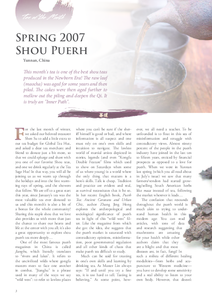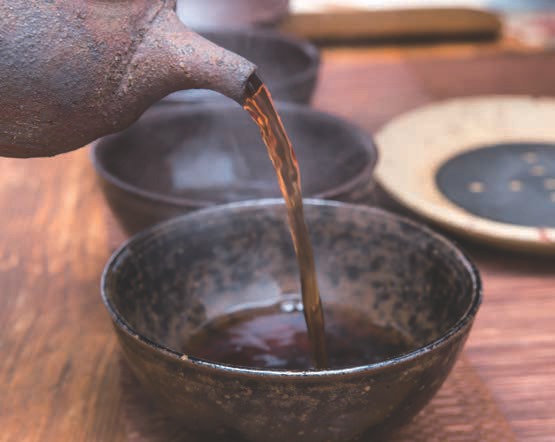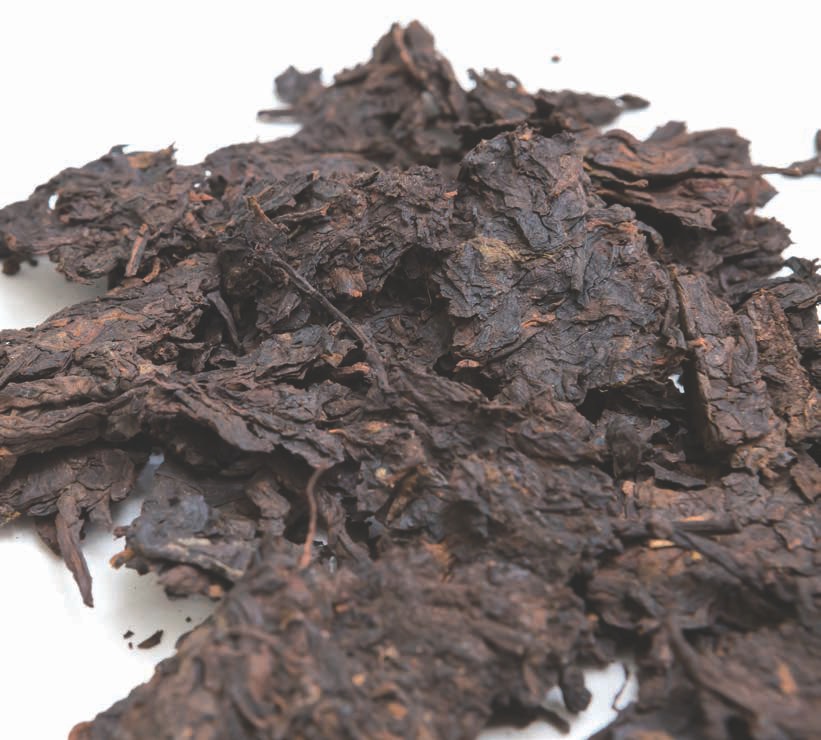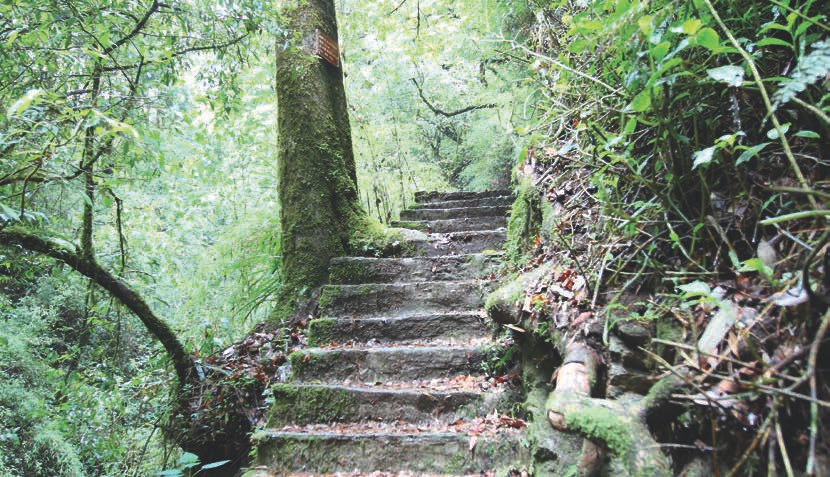
 |
|

This month's tea is one of the best shou teas produced in the Newborn Era! The raw leaf (maocha) was aged for some years and then piled. The cakes were then aged further to mellow out the piling and deepen the Qi. It is truly an "Inner Path".
For the last month of winter, we asked our beloved treasurer Shen Su to add a little extra to our tea budget for Global Tea Hut, and asked a dear tea merchant and friend to donate just a bit more, so that we could splurge and share with you one of our favorite Shou teas, and one we drink regularly at the Tea Sage Hut! In that way, you will all be joining us as we warm up through the holidays and into the first warming rays of spring, and the showers that follow. We are off to a great start this year, since January's tea was the most valuable tea ever donated to us and this month's is also a bit of a bonus for the whole community! Sharing this staple shou that we love also provides us with more than just the chance to share our hearts and life at the center with you all; it's also a great opportunity to explore shou puerh tea more deeply...
One of the most famous puerh magazines in China is called Jianghu, which literally translates to "rivers and lakes". It refers to the uncivilized wilds where gongfu masters meet to face one another in combat. "Jianghu" is a phrase used in many of the ways we say "wild west": to refer to lawless places 3 where you can't be sure if the sheriff himself is good or bad, and where information is all suspect and one must rely on one's own skills and intuition to navigate. The lawless world of martial artists depicted in stories, legends (and even "Kongfu Double Feature" films which used to show on Saturdays when some of us where young) is a world where the only thing that matters is a hero's skills. Talk is cheap. Tradition and practice are evident and real, as survival necessitates that it be so. In her recent English book, Puerh Tea: Ancient Caravans and Urban Chic, author Zhang Jing Hong explores the anthropological and sociological significance of puerh tea in light of this "wild west" filter. Like the magazine from which she got the idea, she suggests that the puerh market is saturated with contradictory opinions, misinformation, poor governmental regulation and all other kinds of chaos that make puerh tea difficult to study.
Much can be said for trusting in one's own skills and learning by drinking tea. As Master Lin always says: "If and until you try a fine tea, it is too hard to tell. Tasting is believing." At some point, however, we all need a teacher. To be unfounded is to float in this sea of misinformation and struggle with contradictory views. Almost ninety percent of the people in the puerh industry have joined in the last ten to fifteen years, enticed by financial prospects as opposed to a love for puerh. When we were in Yunnan last spring (which you all read about in July's issue) we saw that many farmers/vendors had started growing/selling South American herbs like maca instead of tea, following the market wherever it leads...
The confusion that resounds throughout the puerh world is much akin to trying to understand human health in this modern age: You can read articles, with tons of data and research suggesting that mushrooms are amazing for your health while other authors claim that they are a blight and that most diseases are, in fact, fungi! In such a milieu of different healing modalities - from herbs and acupuncture to Western medicine - you have to develop some sensitivity and a real ability to listen to your own body. However, that doesn't mean you don't also need a doctor; you do! You need a healer in whom you can trust, no matter what his or her modality. Such a doctor will encourage you to develop your own intuition while at the same time counseling and examining you to help optimize your health, since they are the expert. Similarly, tea lovers should develop their own ability to evaluate tea and tea wisdom, but we all still need a teacher and tradition.
So much of what we know about tea couldn't have been figured out on our own because it is the result of hundreds, if not thousands of years of accumulated wisdom! Even if we drank tea all day for the rest of our lives we'd never figure it out, just like none of us would ever have learned algebra on our own growing up on an island, no matter how interested in math we are! We need teachers and we need faith in our tradition. That has to come alongside personal exploration. A lot of tea vendors promote the "as you like it" brewing method, suggesting that there is no better or worse and you should just do whatever you like. Such tolerance is good business, and is a good character attribute in general. But tolerance is an attitude, not a Way (Dao). Brewing tea however it pleases you is fine for relaxing and there is a certain truth in letting people be happy, despite their differences. If everyone in the world cultivated more patience for others' differences, this would be a merry world indeed. But such a practice doesn't really have a progress. It leads nowhere, in other words.
Discussing some of the philosophical basis for approaching puerh tea is a good introduction to some of the changes that have come to puerh in this modern, "Newborn Era". If we learn from those who have come before us - who in turn learned from those before them - we can build on that wisdom in a secure and profound way.
As a result, we grow and develop new insights, but insights that are founded firmly on a deep understanding. First, we'd like to discuss the greatest change in puerh in general over the last fifteen or sixteen years since the beginning of the Newborn Era, and then we'll move on to some of the changes that have started in shou puerh specifically.

Puerh tea is sometimes put into the black tea category (remember, this isn't red tea, which is mistakenly called "black tea" in the West), but it should actually have a category all its own. Traditionally, all puerh was fermented before consumption, whether artificially in the case of shou or naturally over time in the case of sheng. As we've mentioned elsewhere, tea lovers back in the day considered new, sheng puerh as "unfinished" and rarely drank it, except to see how it was aging. Therefore, all puerh tea was fermented and fit nicely into the black tea genre, which is categorized by post-production fermentation.
These days, however, much more sheng puerh is consumed young than old. And since sheng puerh vastly overshadows shou in quantity and in historicity (shou only dates back to the sixties or seventies), sheng obviously typifies puerh tea.
One solution to this change in tea production/consumption would be to put young, sheng puerh in the green tea category and aged sheng along with shou in the black tea category. But that seems much more confusing than just giving puerh tea its own genre. We think that since it's the oldest tea, and from the birthplace of all tea, puerh deserves its own genre!
As we have discussed briefly in previous issues, the greatest change in the puerh world in recent years has been the consumption of young sheng puerh. Young, raw puerh is astringent and bitter. It is often very strong for a lot of people. It is also cold in nature, which many Chinese people find to be unhealthy for their constitution. Overconsumption may also result in digestive and/or stomach issues for some people. For these reasons, it was never really drunk (other than to evaluate its aging potential). Puerh tea was considered a "black tea" (not red, which is called "black" in the West) because like all black tea, it underwent post-production fermentation - either naturally through aging in the case of sheng, or artificially through piling in the case of shou. All puerh tea was fermented, in other words. In fact, the data for puerh production from the early 2000's greatly underestimates production quantities by modern standards because young raw tea was not included in the government or factory surveys. The reported quantity of puerh produced in those years therefore only included shou tea. The raw tea was considered unfinished. Like "newmake spirit" in whiskey production, which isn't "whiskey" until it is aged (for at least three years by law), young raw tea was considered to need further processing in the form of aging to be defined as "puerh tea" at all.
Nowadays, the puerh world has changed. Aged teas grow rarer and more expensive all the time, and more and more people are introduced to puerh through young sheng. And many Chinese only consume young, raw tea, preferring it to aged sheng or shou. For the old timers like us, this was a very hard change to make at first. We were amongst those shaking our fists at the new trend, and demanding that "real" puerh had to be aged. Though we've grown out of that fiery stage, it is still easy to understand why we thought that way: imagine if you'd been introduced to puerh at a time when full maturity meant seventy years, and such teas were cheap and abundant. After drinking such marvelous vintages every day for years, it wasn't easy to learn to appreciate the astringency and strength of a young sheng puerh. Nowadays, we've come to see puerh as its own genre of tea - neither green nor black tea - and to love the variety between young sheng, aged sheng, partially-aged sheng and great shou. Each of these kinds of teas has great examples, and is marvelous in its own way - good for certain seasons, times of day or even sentiments depending on the session!
The changes in shou tea have also been great, especially in the last ten years. To understand the recent evolution of shou, we need to first discuss some of its background. In the sixties, the factories of Yunnan, which were controlled by the government through the CNNP (which stands for China National Native Produce & Animal By-Products Import & Export Company), hoped to reduce the aging period of puerh tea. Traditionally, aged sheng tea was considered fully mature at around seventy years. That age isn't arbitrary. The physical structure of puerh changes at such a slow rate by that time that it will take many decades to notice a difference. At around seventy years, the tea is dark and fragrant and won't really change color, though it will continue to change energetically at a constant rate, and in flavor/aroma at a much slower rate. Over time, the aging process slows down, so the difference between a one and five-year-old sheng are great, a five and ten still so, while ten and fifteen not as much, and so on until the difference is measured in decades rather than years. Waiting seventy years is a long time. Even the thirty years which is considered to be "old" by younger puerh lovers is still a long time, so it is no wonder that factories sought out a way to artificially ferment puerh tea.

In the sixties, tea makers in Yunnan traveled to Hunan and Liu Bao to learn about the artificial fermentation of other black teas, hoping to apply that to puerh. They did many experimental batches, figuring out how to apply the process to Yunnan's unique tea and microbial terroir. After enough trial and error, they received license to begin shou production in 1973, which is almost always recorded as the starting date of shou tea in books. Of course, they weren't successful at mimicking aged sheng puerh, but did create a new kind of puerh to be appreciated and evaluated by its own criteria.
After the maocha arrives at the factory, it is piled, misted with water and covered with a thermal blanket. This process is called "wo dui (臥堆)" in Chinese. It is akin to composting. The wet, hot climate allows bacteria to flourish and ferments the tea at a much faster rate. Sometimes, bacteria colonies are continued from batch to batch, and as with all fermented products, much of the quality of shou tea will depend on the vitality and quality of the bacteria!
The first of the two changes in recent shou production is to do with the skill to keep the bacteria thriving from batch to batch, understanding the role they play. The second, and more pronounced change in shou production over the years is a trend towards more full fermentation. Nowadays, most shou tea is fermented from fresh maocha for between forty-five and sixty days, fully fermenting the tea. Such tea has less capacity for aging, mellowing out over the years as opposed to real transformation. In order to achieve the quality and flavor of a well-aged shou tea, such teas will have to be stored for decades. Traditionally, the piling process was done much more skillfully. It is easy to stir the pile and wet it and just wait until it is fully fermented. But in those days, the producers sought to halt the artificial fermentation at a certain degree, which was determined by the customers' order or the nature and grade (leaf size) of the maocha being used. As such, this method required a much greater understanding of tea and shou processing as well. It also allows the tea to age, changing and growing like sheng, though to a lesser extent. In fact, there are some 1980's shou puerhs that could easily be passed off as aged sheng to the uninitiated.
This trend towards easier, faster and more fully-fermented shou is not always good for tea. Back in the day, the factories took great pride in their tea, and you could get tea that was aged, then fermented and compressed. You could find shou tea that was fermented more skillfully, and with a potential to age. Fortunately, such teas are still being produced nowadays, albeit in lesser quantities.
Our tea of the month is a great blend of various teas from Mengku, Lincang, Yunnan. The tea was purchased by a small boutique for private production in 2007. The leaves were of various sizes, from grade three to nine. This large spectrum, from smaller buds to larger, old-growth leaves was common back in the day. (7572 is one famous example, which we have sent out in Global Tea Hut. It has an average leaf size of 7.) This maocha was aged in Jinggu for five years before it was piled, which is unique for modern shou tea. Jinggu is a decent place to age tea in Yunnan, as it is more humid than the capital, or even Mengku where this tea originated.
The five-year-old maocha was fermented to a lesser degree than most shou teas nowadays, leaving room for change and growth. This also means that the process was watched and managed with more care and skill. Stopping the fermentation isn't always the best way to make shou, but it does ensure a greater degree of concern and care for the process, which has to be watched constantly as a result. Also, the reason that inferior, left-over, heavily blended teas have always been used to make shou puerh is that it is inferior to aged sheng. It lacks the vibrancy and Qi, and much of the healing medicine can be lost in the piling of puerh tea. Shou tea is therefore cheaper than young or especially aged sheng puerh. For that reason, good oldgrowth material is rarely used, since it would mean that a vendor had to sell their shou cakes for the same price as sheng, which few customers will pay. Some would also say it would be a waste of quality leaves to pile them, as their potential is much greater as aged sheng.
It is also difficult to find truly clean, chemical-free shou puerh tea, since it is often made up of left-overs, and usually from various regions. The exceptions are always small productions made by tea lovers, like this month's tea. This month's shou is made from a small batch of better leaves, including old-growth, intentionally aged and intentionally piled. And aged in an environment that was suitable for their evolution.
While aged maocha can be piled to make shou, you have to compress the tea right after the piling. Aged loose-leaf shou couldn't be compressed, as the tea leaves would resist the steam and not hold shape. Our tea was aged in Jinggu for five years and then piled for around thirty days before compression, all in Jinggu County. Then, the tea lover producing these teas aged the cakes themselves for another two years before selling them and/or sharing them with friends. So the tea is seven or eight years old from one perspective - if you think of its birth in terms of harvest - or, only three years old if you count from when it was compressed. Either way, the whole process, from selecting and blending the teas to aging them in Jinggu, then in piling them with more intention and for only a month, and then in aging the cakes themselves for two years to allow them to mellow out and loose the piling flavors - all of this was done with a love for tea and a desire to make a great shou puerh. It's no wonder this is one of our favorites!
This magical tea lights up a winter day, with a sweet and thick liquor that tastes of camphor, mushrooms and Taiwanese black sugar. It is a great way to end the winter and celebrate the Chinese New Year. As we drink this tea, fireworks are exploding all over Taiwan. This year's lunar calendar ends quite late compared to the solar calendar, so Chinese New Year is in mid to late February. And "Inner Path", as we call it, is the perfect tea for transitioning from winter to spring, for keeping warm and feeling renewed.
We find the Qi of this magical tea to be surprisingly uplifting for a shou, though we still feel grounded. It isn't as Yin as most shou. It is great in the afternoon or early evening, helping transition from day to night just as we find ourselves drinking it more in late winter. We hope that this great tea finds you surrounded by your own kind of fireworks, reminding you how precious the moment is - each blaze a smile of someone you love, a favorite incense or the smell of an evergreen you pass even when it is snowing. Share in our celebrations with us and help us work towards renewal and growth in the coming year! Let us all toast the growth of this beautiful community in sharing one of our favorite teas!

I wander inwards And find an old forest path Ensorcelled with power. The roots whisper To distant streams That melt the last winter snow. Dancing with shadows, The sunlight glimmers Over the fallen leaves. The Light sees into the Dark, But the Dark doesn't see itself. Not Yet.

This month's tea could be served in a side-handle pot or prepared gongfu. Don't be afraid to make it strong. Shou puerh responds well to a bit more leaf, especially when it is cold outside. This tea is nice when brewed a bit stronger. The larger leaves make it difficult to oversteep. You'll find the liquor is clear and bright no matter how much leaf you use or how long you steep it.
Try putting your hand on your pot and see if you can feel when the tea is ready. Learning to use your senses to hone your tea brewing skills is the only way to mastery. You cannot achieve mastery in tea brewing by using timers, thermometers or scales. While such devices can help us learn, we have to set them down like the crutches they are and learn to gauge the amount of leaf by appearance, and know the temperature of the water from the sound or vibration of the kettle. Similarly, try placing your hands on or near your pot and see if you can sense when it is time to pour. Start with the gross and move to the subtle: feel the temperature of the pot and see if you can detect any change. Then focus on the frequency of its Qi, feeling for an increase in pitch as more and more of the water fills with Tea essence.
At first this may seem esoteric, but that's only because it is difficult to describe in words. As you begin to really feel the changes in frequency from moment to moment, you will also begin to sense when it is time to pour. In gongfu tea, a general rule is that the first rinse is slightly longer, followed by a flash steeping and then the steepings slowly increase in duration. With fine teas, you can have two or three flash steepings in the middle. But this is only a general formula, and can't be substituted for real experience brewing a tea!